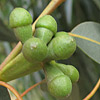The common name of Eucalyptus gomphocephala, Tuart tree, differs from the common names of other eucalyptuses, which usually contain the phrase gum.
Eucalyptus gomphocephala is a tall tree with a broad crown, which is used in forestation for wood production, windbreakers, decorative branches, stabilization of sands near the sea shore and afforestation of alkaline chalky soils.
Tuart tree has a short trunk and a broad crown. It reaches a height of 25-35 m and some individuals reach a height of 42 m. Its diameter at breast height can reach 2 m. The root system, which includes horizontal 8-12 m long roots and vertical roots which reach a depth of 3 m, enables the tree to survive under dry conditions and in chalky soils.
It has a thick and gray to dark gray bark that does not peel off. It is characterized by thin fibers running along the trunk, with grooves between them – as if someone combed the trunk with a fine comb. This is one of the conspicuous signs for identifying this species.
The wood is light yellow, very hard and damage-resistant. A special characteristic is that nails and hooks that are driven into it do not rust. In Australia it is used for railway sleepers, for construction of railway wagons and for posts, it can also be used for production of simple furniture.
The juvenile leaves (in seedlings and saplings) are opposite, thin and triangular, and reach a length of 7 cm. The mature leaves are alternate, darker and thicker. They are falcate and reach a length of 17.5 cm.
Tuart tree, like the entire family carries bisexual flowers. The raceme has 3-7 white flowers on thick and flat pedicels. The tree’s flower bud is round. The operculum is semicircular and covers the flower like a cap. It is shed when the stamens straighten, and the typical flower, which has no petals, is revealed. The operculum is the characteristic part and gives the genus Eucalyptus its name. The origin of the name in Greek is eu-kaluptos, which means “well covered”. In our case, the shape of the operculum of Tuart tree also gives the name of the species – gomphocephala, which in Latin means “swollen head”.
The fruits are bell-shaped, 1.5x2.0 cm, and carry tiny seeds (approximately 90 viable seeds per gram). There is a cross-shaped groove at the head of the fruit, which resembles the head of a screw, which is the source for the Hebrew name of the species – “nail”. In Australia the tree blooms in autumn, during March-April, whereas in Israel it blooms in the spring-summer, during June-July.
Tuart tree is endemic to Western Australia in the region near the southern part of the west coast, a short distance from the city of Perth. Its habitat is a strip that contains limestone rock and sand dunes. The climate in its habitat is Mediterranean, i.e. cool and rainy winter and hot and dry summer. It almost became extinct in its natural habitat due to its extensive logging, and great efforts are now made to preserve it in areas in which it grew in the past.
The natural conditions under which it grows, the speed of its growth, and especially the quality of its wood, have turned it into a very suitable tree for plating forests in other Mediterranean regions around the world, including in Israel, where it was first planted already in 1910. Tuart tree is the second most common eucalyptus tree planted in KKL (Jewish National Fund) forests, where over 15,000 dunams were planted with this tree. It is successful in mountainous areas in the north and center of the country and in the southern lowland “Shefela”, and only the low precipitation prevents it from succeeding as a forest tree in the Negev. It is used as a boulevard tree in many roads in the center and south of the country. Its hybrid seeds with Eucalyptus maculata that were collected from a plot in Mishmar Ha’emek and were grown and planted by mistake as Tuart tree saplings developed into unfertile and unfamiliar spherical shrubs in several plots, were first discovered near Nir Moshe by the KKL forester Judah Judah. After an attempt at vegetative propagation led by Prof. Joseph Riov, demand for saplings of this plant as an ornamental plant greatly increased and they are even exported to different countries. This hybrid was named “Kaduri KKL” which means“The KKL Spheres”.
Its success in mountainous and chalky habitats in Israel have led to its being called “The Mountain Eucalyptus” in Israel.
In his diary, Yosef Weitz describes a proposal from 1959 which led the then government ministers Levi Eshkol and Pinchas Sapir to plant 150-200 thousand dunams of Tuart tree and Eucalyptus camaldulensis (River-Red-gum) in order to supply raw material for the Hadera Paper Plant.
The tree belongs to the Myrtaceae family which includes 5650 species of evergreen woody plants in 130-150 different genera, where the most familiar of these are the myrtle, the guava, the feijoa and the callistemon. The genus Eucalyptus includes about 700 species and today it is the most commonly planted genus for wood production in commercial plantations around the world.
Written by Zvi Avni






